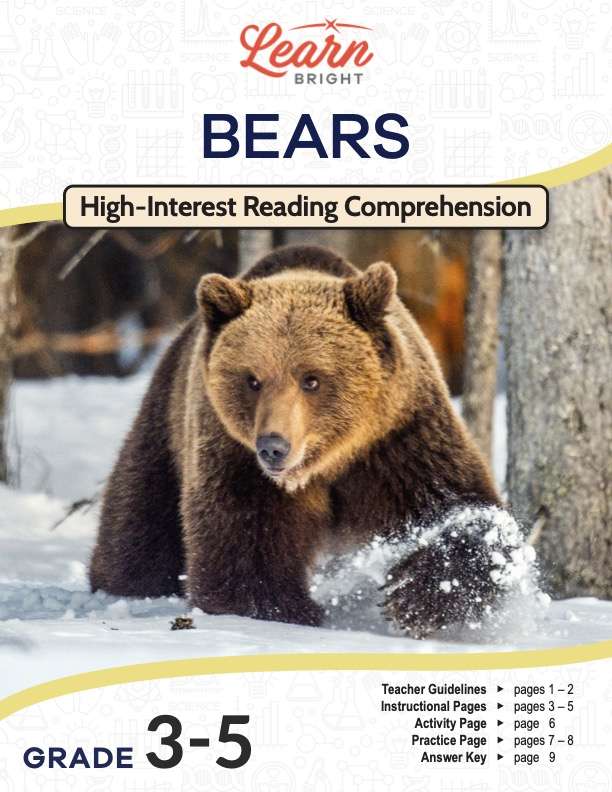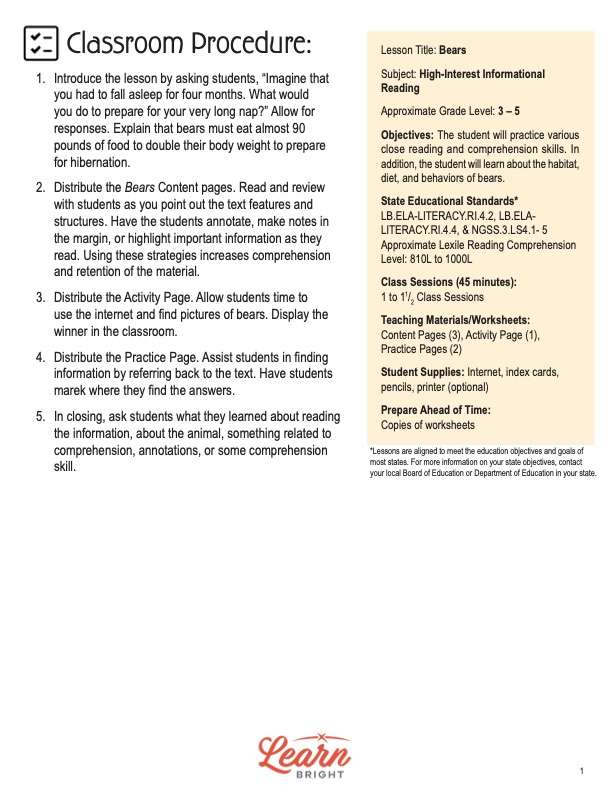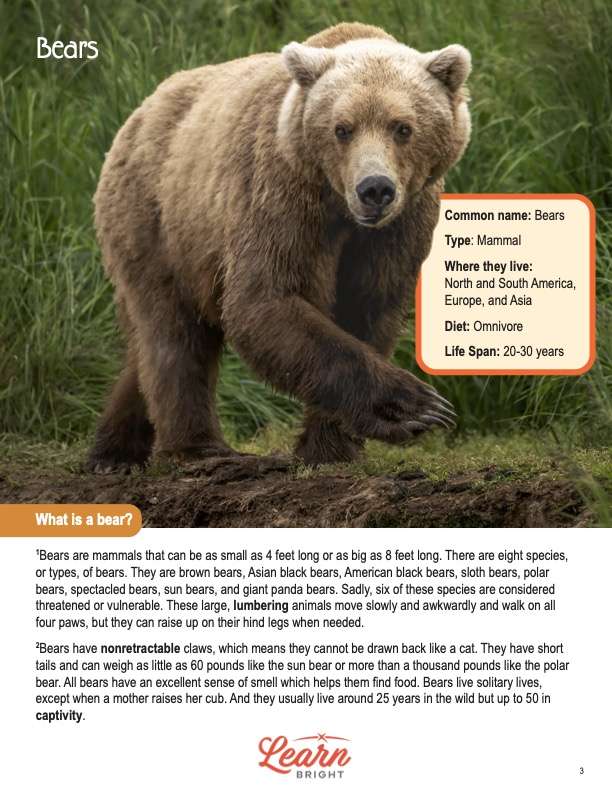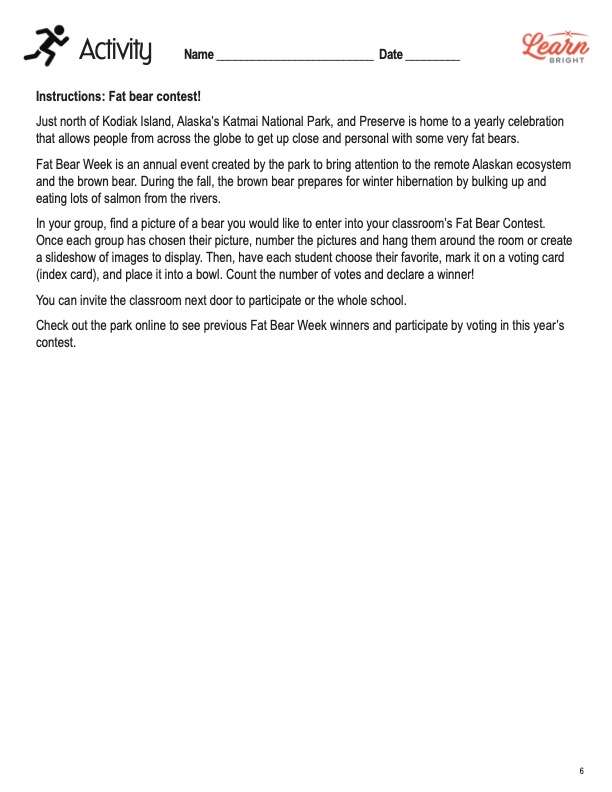Description
What our Bears lesson plan includes
Lesson Objectives and Overview: Bears is a high-interest reading comprehension lesson plan. As such, students will practice various close reading and comprehension skills. In addition, they will learn about the bear’s habitat, diet, and behaviors. This lesson is for students in 3rd grade, 4th grade, and 5th grade.
Classroom Procedure
Every lesson plan provides you with a classroom procedure page that outlines a step-by-step guide to follow. You do not have to follow the guide exactly. The guide helps you organize the lesson and details when to hand out worksheets. It also lists information in the yellow box that you might find useful. You will find the lesson objectives, state standards, and number of class sessions the lesson should take to complete in this area. In addition, it describes the supplies you will need as well as what and how you need to prepare beforehand.
Teacher Notes
The teacher notes page provides an extra paragraph of information to help guide the lesson and remind you what to focus on. It explains that you can teach this lesson in a whole-class setting or to an independent, small group as an activity. The blank lines on this page are available for you to write out thoughts and ideas you have as you prepare the lesson.
BEARS LESSON PLAN CONTENT PAGES
What Is a Bear?
The Bears lesson plan contains three content pages. To start off, it provides a small box with basic background information about bears. They are types of mammals that live in North and South Americas, Europe, and Asia. They are omnivores, meaning they eat both meat and plants, and they can live for 20–30 years.
Bears can be as small as four feet long or as big as eight feet long. There are eight species, or types, of bears—brown bears, Asian black bears, American black bears, sloth bears, polar bears, spectacled bears, sun bears, and giant panda bears. Sadly, six of these species are considered threatened or vulnerable. These large, lumbering animals move slowly and awkwardly. They walk on all four paws, but they can rise up on their hind legs when needed.
Bears have non-retractable claws, which means they cannot be drawn back like a cat. They have short tails and can weigh as little as 60 pounds, like the sun bear, or more than a thousand pounds, like the polar bear. All bears have an excellent sense of smell that helps them find food. Bears live solitary lives, except when a mother raises her cub. And they usually live around 25 years in the wild but up to 50 years in captivity.
What They Eat
Have you ever seen a bear holding a honey jar? That’s because all bears love the sweet taste of honey! But they eat more than just honey. Each bear species has a different preferred diet, but they are
all considered omnivores because they eat both plants and animals. For example, polar bears mostly eat seals while giant pandas mainly
eat bamboo and some small animals. American black bears love the taste of berries and insect larvae. Brown bears in Alaska gorge (greedily eat a large amount) on salmon by plucking them right out of the stream as they jump. And sloth bears are super fast eaters, even though they are called sloths, which means lazy. They can tear a hole in a termite mound and inhale a whole meal in seconds!
Some days, you might feel as hungry as a bear. Did you know that brown bears will eat all day and night, which can be up to 90 pounds of food during the fall? This is because they must stock up for the time when they hibernate and must live off of a layer of stored body fat. Once the bear has eaten enough and the cold comes, it will waddle into a den and hibernate. Hibernation is a physical state in which a bear’s heart rate, body temperature, respiration (breathing), and metabolism slow down.
A female brown bear will enter the den pregnant and have her cub, or baby bear, during her hibernation. Female bears will have up to four cubs during this time. After a few months, when hibernation is complete, they are strong enough to walk next to their mother to leave the den. There is an exception: sloth bear cubs ride on their mother’s back!
Other Interesting Facts
More than 10 million years ago, the dawn bear was the first bear to live on planet Earth. Ursavus elemensis is the earliest known actual bear, a small, dog-sized bear. It lived in subtropical forests throughout Europe. It is believed by scientists to be the ancestor of all eight living bear species.
Many people don’t realize that bears are related to walruses, seals, and sea lions. And even though koalas are often called koala bears, they are marsupials and not bears at all!
Bears that live up north will sleep during the winter, but they don’t hibernate. Remember that hibernating bears lower their body temperature, breathing, and heart rate. So bears in the north take a really, really long nap. And sometimes, they wake up during the nap, go outside in the cold to wander around, and then go back to sleep again.
In addition, bears are ecosystem engineers, which means they have the power to change their environment. For example, when they forage for food, bears spread plant and berry seeds that hold on to their fur and come out in their droppings. They are also essential links in the food web. As predators, bears help maintain populations of deer and other prey, like salmon.
Habitat loss from growing human populations impact bears in a big way. Losing their land means bears have less area in which to hunt and a higher chance of running into humans. And when bears come into contact with humans, sometimes there are serious conflicts. For example, bears are killed out of concern for human safety or for eating livestock or crops. Some species of bear are hunted for one of their organs called the gallbladder. Bile inside the gall bladder is a vital ingredient in traditional Chinese medicine. Poachers, or people who illegally kill animals, will target bears for their gallbladders, paws, and skin.
BEARS LESSON PLAN WORKSHEETS
The Bears lesson plan includes two worksheets: an activity worksheet and a practice worksheet. Each one will help students solidify their grasp of the material they learned throughout the lesson. You can refer to the classroom procedure guidelines to know when to hand out each worksheet.
FAT BEAR CONTEST ACTIVITY WORKSHEET
For the activity, students will first read a little bit of information about something called Fat Bear Week. Just north of Kodiak Island in Alaska, people from across the globe gather for a yearly celebration called Fat Bear Week. Students will split into groups, and each group will find a picture of a bear that they want to enter into the Fat Bear Contest. You will number all the pictures and hang them up for display. Each student will choose their favorite and mark their vote on an index card. You will collect the index cards and count the votes to find the winner.
You could also invite a neighboring classroom or even the whole school to participate in the contest. Additionally, check out the park online to see previous Fat Bear Week winners and have students participate by voting for this year’s contest.
BEARS PRACTICE WORKSHEET
The practice worksheet requires students to answer a series of 11 questions. These questions all relate to the content pages, so students will need to refer to them often for the answers. In addition, each question provides which reading tool the question corresponds to, such as text feature, vocabulary, or comprehension.
Worksheet Answer Keys
At the end of the lesson plan document is an answer key for the practice worksheet. The correct answers are all in red to make it easier for you to compare them with students’ responses. If you choose to administer the lesson pages to your students via PDF, you will need to save a new file that omits these pages. Otherwise, you can simply print out the applicable pages and keep these as reference for yourself when grading assignments.










